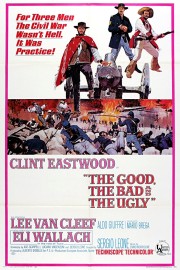The Good, the Bad and the Ugly
Whatever risks Sergio Leone took with “A Fistful of Dollars” and “For a Few Dollars More” are taken further in his masterpiece, “The Good, the Bad and the Ugly.” The opening credits are splashier. The Ennio Morricone music, with one of the most famous themes in film history, is bigger. The visual style is more exaggerated. And the story is bolder in scope.
It all starts with a shootout. We don’t see the bullets fly, but we see as a couple of desparados ride into town, and then go into a bar where the guns go off. Then we see a wild haired gunslinger crash through the window. Leone freezes the frame as the words, “the ugly,” flash on-screen while Morricone’s coyote theme cries out. We will find out later that “the ugly’s” name is Tuco (Eli Wallach, in one of the great, hilarious supporting performances). Tuco has a little rouse going with Blondie (Clint Eastwood). You see, Tuco has a pretty high price on his head. Blondie takes him in to collect the reward, then slices the rope with his rifle as Tuco is about to hang. The two ride off, then split the money. Blondie, we learn, is “the good” of our story, although he will eventually leave Tuco in the desert after Tuco’s bounty is up to $3000.
As that charade is going on, we also see “the bad,” and the eventual story that will be the focus of the remainder of the film. Angel Eyes (Lee Van Cleef) is a cold-blooded killer. He goes to the home of a family man who used to be in the army looking for information about a man named Jackson. He’ll find out even more, such as the existence of a stolen trunk of Civil War gold. As his search for it progresses, he will kill more than the messenger. Eventually his path will cross with Blondie and Tuco; all three will have a vital piece of information that will keep them alive until the gold is found.
How could such a story occupy a 3-hour running time? Leone has plenty of ideas up his sleeve. We see a ghostly carriage with dead bodies, except for one who knows the secrets of the gold. We see Tuco and Blondie in a Civil War prison camp, where Angel Eyes has set himself up as a Sergeant so that he can use “enhanced interrogation” to learn the info he doesn’t have about the gold. There’s a even more impressive Civil War sequence to come with Tuco and Blondie, who come upon a Union camp and a captain who is charged with holding a bridge, which our good and ugly friends will blow up in a scene reminiscent of “The Bridge on the River Kwai.”
And then there’s the final scene in the cemetery. At last, all three have made it to where the gold is at. But none of them are looking to go quietly. All three knows what must transpire. They spread out in a circular area (which we recognize from an earlier scene in this movie, as well as the climax of “For a Few Dollars More”) at the center of the cemetery. Leone mixes wide shots and extreme closeups of the character’s eyes to create an unnerving level of suspense. The rest of it is all Morricone, whose score is one of the greatest in film history not just in musical creativity but also in the impact it has on the film itself. Throughout the film we have heard Morricone’s iconic theme orchestrated different way for each character; Morricone has defined the brutal heat of the desert with harsh and haunting atmospheres and orchestrations; and we’ve also heard some genuinely beautiful music getting at the sadness and brotherhood of those fighting in the Civil War. His music has also displayed the joy of Tuco when he finally finds the cemetery in the iconic piece “The Ecstacy of Gold.” As the characters get ready for one final standoff, with each others life in the other one’s hands, Morricone starts slow before building up to an unforgettable climax.
Both music and film have had a profound impact on me over the years. If you want to know the inspiration for my third album as a composer, “Sonic Visions of a New Old West”, look no further than Leone’s “trilogy.” The music also played a major role in the creation of an “audio scene” I did for an assignment in college, and Morricone’s “The Trio” was an inspiration for my score to the short film “Walpurgis Night.” Still, while the other films in Leone’s trilogy are important to me as well, “The Good, the Bad and the Ugly” is the one I’ve continued to gravitate towards for inspiration. It’s a great entertainment that gets better with age. Even if it does occupy a place in the disreputable genre of the “spaghetti western,” “The Good, the Bad and the Ugly” is high art not for its content but in the way Leone presents it. We get the expansive Spanish locations of the first two films, as well as a desert that could kill our protagonists with the heat. We get characters that appear world-weary and have grizzled faces. We get a vision of the American West that is influenced less by the films of John Ford and more by the ideas of how an Italian shooting in Spain sees the American West. We get moments of unexpected gravity along with moments of inspired comedy (mostly courtesy of Tuco). And we get a film as much about honor and loyalty as it is about three killers making themselves a lot richer. All roads lead to gold for the characters, while the viewer gets a masterpiece of the highest order.
*Also available for you are Brian’s reviews of “A Fistful of Dollars” and “For a Few Dollars More”.










